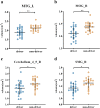Behind the wheel: exploring gray matter variations in experienced drivers
- PMID: 38618564
- PMCID: PMC11015830
- DOI: 10.7717/peerj.17228
Behind the wheel: exploring gray matter variations in experienced drivers
Abstract
Background: Driving is a complex skill involving various cognitive activities. Previous research has explored differences in the brain structures related to the navigational abilities of drivers compared to non-drivers. However, it remains unclear whether changes occur in the structures associated with low-level sensory and higher-order cognitive abilities in drivers.
Methods: Gray matter volume, assessed via voxel-based morphometry analysis of T1-weighted images, is considered a reliable indicator of structural changes in the brain. This study employs voxel-based morphological analysis to investigate structural differences between drivers (n = 22) and non-drivers (n = 20).
Results: The results indicate that, in comparison to non-drivers, drivers exhibit significantly reduced gray matter volume in the middle occipital gyrus, middle temporal gyrus, supramarginal gyrus, and cerebellum, suggesting a relationship with driving-related experience. Furthermore, the volume of the middle occipital gyrus, and middle temporal gyrus, is found to be marginally negative related to the years of driving experience, suggesting a potential impact of driving experience on gray matter volume. However, no significant correlations were observed between driving experiences and frontal gray matter volume.
Conclusion: These findings suggest that driving skills and experience have a pronounced impact on the cortical areas responsible for low-level sensory and motor processing. Meanwhile, the influence on cortical areas associated with higher-order cognitive function appears to be minimal.
Keywords: Driving experience; Driving skill; Gray matter volume; Sensory and motor processing.
© 2024 Chen et al.
Conflict of interest statement
The authors declare that they have no competing interests.
Figures



Similar articles
-
Greater cerebellar gray matter volume in car drivers: an exploratory voxel-based morphometry study.Sci Rep. 2017 Apr 18;7:46526. doi: 10.1038/srep46526. Sci Rep. 2017. PMID: 28417971 Free PMC article. Clinical Trial.
-
Neuroanatomical variations as a function of experience in a complex daily task: A VBM and DTI study on driving experience.Brain Imaging Behav. 2018 Jun;12(3):653-662. doi: 10.1007/s11682-017-9725-8. Brain Imaging Behav. 2018. PMID: 28447245
-
The Association of Retinal Microvasculature With Gray Matter Changes and Structural Covariance Network: A Voxel-Based Morphometry Study.Invest Ophthalmol Vis Sci. 2023 Dec 1;64(15):40. doi: 10.1167/iovs.64.15.40. Invest Ophthalmol Vis Sci. 2023. PMID: 38153752 Free PMC article.
-
[The relationship between auditory verbal hallucination and gray matter volume and cortical thicknessin first-episode childhood-onset schizophrenia].Zhonghua Yi Xue Za Zhi. 2024 Dec 3;104(45):4132-4139. doi: 10.3760/cma.j.cn112137-20240712-01596. Zhonghua Yi Xue Za Zhi. 2024. PMID: 39622744 Chinese.
-
Brain gray matter alterations and associated demographic profiles in adults with autism spectrum disorder: A meta-analysis of voxel-based morphometry studies.Aust N Z J Psychiatry. 2016 Aug;50(8):741-53. doi: 10.1177/0004867415623858. Epub 2016 Jan 14. Aust N Z J Psychiatry. 2016. PMID: 26769980 Review.
References
-
- Anderson SR. On the development of morphology from syntax. Historical Morphology. 1980;1980:51–70. doi: 10.1515/9783110823127. - DOI
-
- Bethlehem RAI, Seidlitz J, White SR, Vogel JW, Anderson KM, Adamson C, Adler S, Alexopoulos GS, Anagnostou E, Areces-Gonzalez A, Astle DE, Auyeung B, Ayub M, Bae J, Ball G, Baron-Cohen S, Beare R, Bedford SA, Benegal V, Beyer F, Blangero J, Blesa Cábez M, Boardman JP, Borzage M, Bosch-Bayard JF, Bourke N, Calhoun VD, Chakravarty MM, Chen C, Chertavian C, Chetelat G, Chong YS, Cole JH, Corvin A, Costantino M, Courchesne E, Crivello F, Cropley VL, Crosbie J, Crossley N, Delarue M, Delorme R, Desrivieres S, Devenyi GA, Di Biase MA, Dolan R, Donald KA, Donohoe G, Dunlop K, Edwards AD, Elison JT, Ellis CT, Elman JA, Eyler L, Fair DA, Feczko E, Fletcher PC, Fonagy P, Franz CE, Galan-Garcia L, Gholipour A, Giedd J, Gilmore JH, Glahn DC, Goodyer IM, Grant PE, Groenewold NA, Gunning FM, Gur RE, Gur RC, Hammill CF, Hansson O, Hedden T, Heinz A, Henson RN, Heuer K, Hoare J, Holla B, Holmes AJ, Holt R, Huang H, Im K, Ipser J, Jack CR, Jr, Jackowski AP, Jia T, Johnson KA, Jones PB, Jones DT, Kahn RS, Karlsson H, Karlsson L, Kawashima R, Kelley EA, Kern S, Kim KW, Kitzbichler MG, Kremen WS, Lalonde F, Landeau B, Lee S, Lerch J, Lewis JD, Li J, Liao W, Liston C, Lombardo MV, Lv J, Lynch C, Mallard TT, Marcelis M, Markello RD, Mathias SR, Mazoyer B, McGuire P, Meaney MJ, Mechelli A, Medic N, Misic B, Morgan SE, Mothersill D, Nigg J, Ong MQW, Ortinau C, Ossenkoppele R, Ouyang M, Palaniyappan L, Paly L, Pan PM, Pantelis C, Park MM, Paus T, Pausova Z, Paz-Linares D, Pichet Binette A, Pierce K, Qian X, Qiu J, Qiu A, Raznahan A, Rittman T, Rodrigue A, Rollins CK, Romero-Garcia R, Ronan L, Rosenberg MD, Rowitch DH, Salum GA, Satterthwaite TD, Schaare HL, Schachar RJ, Schultz AP, Schumann G, Schöll M, Sharp D, Shinohara RT, Skoog I, et al Brain charts for the human lifespan. Nature. 2022;604(7906):525–533. doi: 10.1038/s41586-022-04554-y. - DOI - PMC - PubMed
MeSH terms
LinkOut - more resources
Full Text Sources

